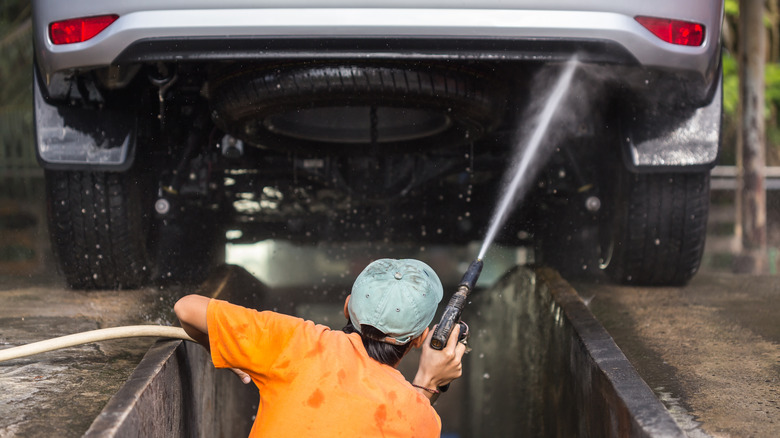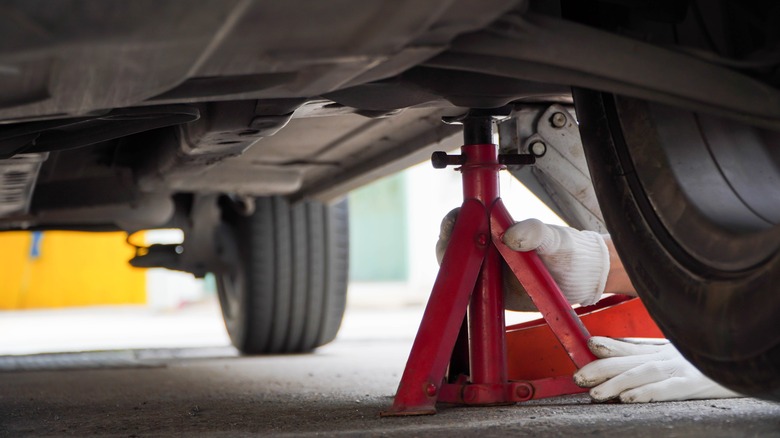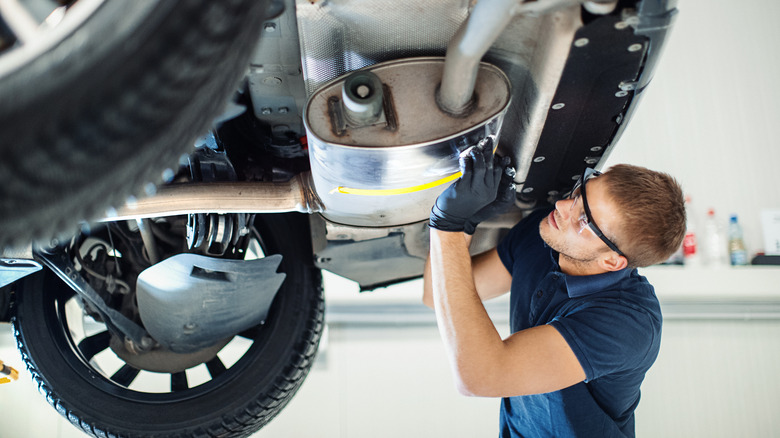How To Clean Your Car's Undercarriage: A Step-By-Step Guide
We may receive a commission on purchases made from links.
For many of us, a car's undercarriage is subject to the old adage: "Out of sight, out of mind." Unfortunately, leaving the undercarriage uncleaned for long periods can lead to rust, and rust can lead to irreversible deterioration of important parts. It's the same reason you should clean your engine bay regularly. Furthermore, built-up grime in the undercarriage can negatively affect your suspension, causing a bumpier ride and jerky handling.
That's why you should give your undercarriage a thorough cleaning every few months and even more frequently if you drive through a lot of mud, rain, snow, ice, salt, and dirt. The process is a little more involved than just blasting the bottom with a hose. Water alone won't remove hydrophobic grease and oils, materials that can form sticky layers of grime that trap dirt.
Thus, we've broken down the steps to cleaning your car's undercarriage into a simple guide. It's recommended you follow everything in order.
Preparation is the key to success
Get your tools and materials together first.
You'll need the following:
- A garden hose with a pressurized spray nozzle
- A scrub brush
- A degreaser liquid solvent (example: WD-40 Specialist Degreaser)
- A car wash or car shampoo (example: Griot's Garage Undercarriage Spray)
Optional tools and materials that help:
- Car jacks or stands
- A power washer with a high-pressure spray gun (example: Sooprinse High Pressure Washer Gun)
- A carwash foam gun for garden hoses (example: SwiftJet Car Wash Foam Gun)
- Undercarriage protectant spray (example: Chemical Guys Bare Bones Shine Spray)
Once you have your tools, it's time to start prepping your vehicle. You'll want visibility and access to the undercarriage, so your best bet is to raise it up on jack stands. Do not use the scissor jacks that come with spare tire kits, since these aren't typically reliable enough to support the car while you work under it. Indeed, it's not a good idea to "go cheap" with jack stands.
If you don't have jacks, you can drive halfway onto a curb or low wall to make space underneath the car. Should you go this route, employ your emergency brake and make sure the car is safe and stable.
Give the entire car a quick rinse with the hose or powerwasher, paying extra attention to the wheel wells and tires so you won't have mud rinsing down from the top of the vehicle and spoiling your hard work. Once done, you can clean the undercarriage.
Get rid of the grease with a degreaser
This step is the most important, since it confronts the route of the issue: Built-up grease. Water-dissolved substances, like mud and slushy snow, typically drip and fall off as the water evaporates. But oils, salts, and other sticky substances that come in contact with your undercarriage build up over time, forming greaseballs that can trap dirt and debris.
If you have a powerful enough hose or powerwasher, give your undercarriage a quick spray to remove loose grime. Wait a bit to let it drip-dry, and then bust out your degreaser.
Examine the undercarriage for parts that look greasy, and give them a good coating. Cracks, crannies, electrical wires, and the steering rack are often covered in oil, so focus on these areas first. This is also a good opportunity to clean your wheel wells, so feel free to degrease those as well.
Once you've coated the hotspots of grease with the degreaser, scrub them with a brush to wick away as much gunk as you can. You don't need to be too precise here, since your powerwasher or hose will do the rest.
The final spraydown and protective coat
After the degreasing comes the full cleaning. If you have a car wash or car shampoo fluid, this is the best time to use it. Spray down the entire underside with your cleaner, making sure to hit all the nooks and crannies.
Now, blast the heck out of your undercarriage with either a pressurized garden hose or a power washer. If your car is raised on jacks or a curb, you should be able to target all sides. Muddy water, degreased residue, and grime will likely splatter all over the place. This is normal.
You can stop once your spray ejects only clear water. Let the water drip off a bit, and use a flashlight to check for any remaining residue. Use your degreaser and brush to eliminate any, then give it a final blast with the hose.
Finally, you have the option to add a protective coat to your undercarriage, as it is one of the top ways to protect your car from rust. These protectants usually come as a spray, such as the Chemical Guys Bare Bones Shine Spray.
If you store your car in a garage where it's slow to dry, you may also want to give your entire car a quick dry with a hand cloth or old towel.
After all is said and done, you can rest easy knowing that your car's undercarriage is squeaky clean and ready for the road.



